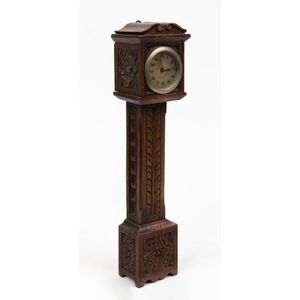Chip Carved Oak Miniature Grandfather Clock, circa 1930, 30-hour Movement
A chip carved oak miniature grandfather clock, circa 1930, with a 30 hour movement and an Arabic dial, 36 cm high, 7 cm wide, 5 cm deep
You must be a subscriber, and be logged in to view price and dealer details.
Subscribe Now to view actual auction price for this item
When you subscribe, you have the option of setting the currency in which to display prices to $Au, $US, $NZ or Stg.
This item has been sold, and the description, image and price are for reference purposes only.
- Chip Carving - Chip carving, also known as spoon carving is a traditional woodworking technique that involves removing small, V-shaped chips of wood from a flat surface using a carving knife. The technique is often used to create intricate geometric patterns and designs on wooden objects such as bowls, spoons, and boxes.
It is a form of relief carving, which means that the design is raised above the surface of the wood rather than being carved into it. It's a relatively simple technique that does not require a great deal of skill or experience, making it a popular choice for both beginners and experienced woodworkers. - Oak - Native to Europe and England, oak has been used for joinery, furniture and building since the beginning of the medieval civilisation. It is a pale yellow in colour when freshly cut and darkens with age to a mid brown colour.
Oak as a furniture timber was superceded by walnut in the 17th century, and in the 18th century by mahogany,
Semi-fossilised bog oak is black in colour, and is found in peat bogs where the trees have fallen and been preserved from decay by the bog. It is used for jewellery and small carved trinkets.
Pollard oak is taken from an oak that has been regularly pollarded, that is the upper branches have been removed at the top of the trunk, result that new branches would appear, and over time the top would become ball-like. . When harvested and sawn, the timber displays a continuous surface of knotty circles. The timber was scarce and expensive and was used in more expensive pieces of furniture in the Regency and Victorian periods. - Circa - A Latin term meaning 'about', often used in the antique trade to give an approximate date for the piece, usually considered to be five years on either side of the circa year. Thus, circa 1900 means the piece was made about 1900, probably between 1895 and 1905. The expression is sometimes abbreviated to c.1900.
- Movement - The technical name for the workings of a clock or watch, and does not include the dial or case.
This item has been included into following indexes:
